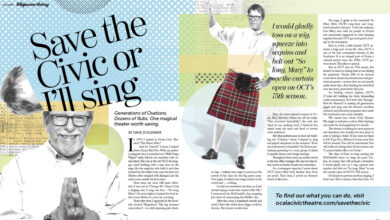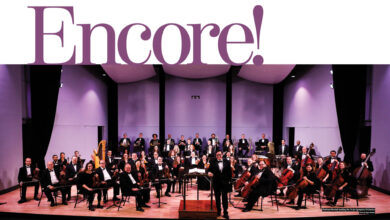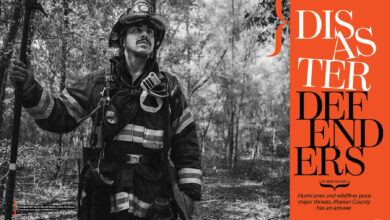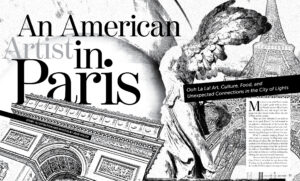
My fascination with Paris started in eighth grade with my lovely French teacher, Miss Cosby. She not only taught the language but also shared stories about the city of Paris and its people.
“They are often offended if you don’t at least try to speak French,” she had warned as she painted a vivid picture of the Louvre, the Notre Dame, the city design and intricate roadways. Historic, sophisticated, mysterious and intimidating, Paris began to call to me that year.
While I continued studying French for a few years, my passion for Paris truly came alive during art school. The Art History classes sparked a love of Italian and French art that led to the greatest romance of my life, my love affair with art. Travel filled with art, architecture and cuisine enriches my soul like nothing else, offering fresh perspectives and inspiration.
Decades after that eighth grade French class, I finally embarked on my dream trip. Meeting my Aunt Sydney at Paris Charles-de-Gaulle (CDG) airport, we eagerly began our 11-day adventure. We powered through the fatigue from more than 24 hours of travel — including the time difference — and hailed a taxi. Despite years of language study, I was insecure about my accent. Fortunately, Sydney is a seasoned traveler, and she had prepared little slips of paper containing the address to our Vrbo apartment to hand to the taxi driver. Voila!
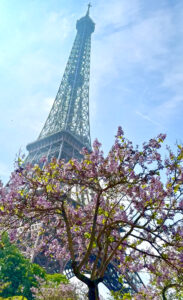
As we rode into the city, we recounted our journeys thus far. Sydney had come from Minneapolis/St. Paul and I had come from Ocala. We discovered a shared topic of conversation on both of our flights: Taylor Swift. Apparently the high cost of a TayTay concert in the U.S. (average ticket price is over $1,200 per seat) drives people to spend those thousands on travel to other countries where her tickets are mere hundreds.
Deep in our conversation about international Swifties, a dull thud and a jerk interrupted us when our taxi driver hit someone on a motorcycle. Arms swaying and shoulders shrugging, the two drivers came to the conclusion that no damage was done so we continued on to our apartment in the Picpus district of Paris.
We rode the tiny two-person elevator one at a time, each with our luggage, up to the 7th floor. Looking out over the family neighborhood off the Place de la Nation, we saw bakeries, shops, people, small European cars, and pigeons. Lots of noisy pigeons. We were situated less than 15 minutes by metro from central Paris’s landmarks. But first, a bit of shopping to stock our small kitchen.
We walked to the local street market and marveled at the fresh foods on display. Gorgeous produce, exotic seafood, meats, cheeses, jams, breads, quiches, pastries, everything you might imagine. Awkwardly trying out my French, I succeeded in making purchases if not having long conversations. A vendor guessed I was Norwegian. Semi-victory.
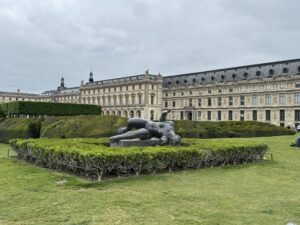
Still energized despite not having slept, we set out in the beautiful, sunny, 65-degree weather. We bought metro passes and began to explore central Paris. We picked up our Paris Museum Passes (good for entrance at all city museums – a great deal) and passed by so many sights I have seen in books and movies, I almost felt like I had already been there. Like I had come home to places that have lived in my mind for ages. Except for one thing. I was surprised to see that all of the buildings were nearly the same color.
“There must have been a sale on limestone that year,” I joked with Sydney after realizing the scenery didn’t change no matter where we went. I wasn’t far off. Paris’s buildings have a warm cream color broken up by black iron balconies and decor, with added gold embellishments. The buildings were made from Lutetian Limestone, or “Paris Stone.” It creates a uniform style with little variation between the yellow-grey tones, and it belies the rich artistic and cultural diversity held within.
The following day we boarded the famous Big Red Bus and rode on the top deck, touring all the major sights. The “hop on, hop off” bus lets you get a view of everything before doing the deep dives. Sydney had donned her red beret, which became the focal point of my snapshots of the Notre Dame cathedral, the Eiffel Tower, the Champs Elysées, La Madeleine Greek Temple, the Musee d’Orsay, the Ponte Neuf, and the Paris Opera.
Feeling like Paris pros already but just getting started — we sat down at a crowded cafe to refuel. We were enjoying our salads (the goat cheese on Sydney’s salad was amazing! Why are all of the cheeses so good in France? What are they feeding their cows?) and I overheard the table next to us struggling to pay their bill because of American Express cards not being accepted and lack of cash Euros. The conversation was in English, the diners were American. They soon figured it out and continued chatting. I heard one of them mention Cedar Creek and I couldn’t be discreet about my casual eavesdropping any more. I turned towards them to interrupt.
“Sorry but I have to stop you guys for a second. Did you just say Cedar Creek? Do you mean in Florida?”
“Yes,” the man said, and all four of them looked at me with a look of surprise.
“I’m from Ocala…” I began.
“We are from Ocala!!” they squealed in unison.
After we recovered and closed our gaping jaws, we figured out that, of course, we have cross-ties to places and people in Ocala. It just so happened they were on their first sleepless day in Paris, having traveled there for the Taylor Swift concert. The world is smaller than any of us could imagine.
After that serendipitous encounter, we went to the Louvre. The largest museum in the world, by size and reputation, the Louvre was the only place on the planet I knew I needed to visit before dying. Under the famous glass pyramid entrance (think DaVinci Code), we purchased little Nintendo screens with earphones, and hung them round our necks to do a self-guided tour. But after walking around in circles we abandoned the gameboys and just wandered. There is no place you can end up in this museum that isn’t worthwhile. There is no corner you can turn without saying, “Woahhh,” heading towards whatever masterpiece from another time and place you are drawn to.
As we roamed the giant, ornate halls, I was feeling elated but also exhausted. Fueled by passion, I took hundreds of pictures that I would never post just to remember details, and all the while the Mona Lisa and Winged Victory were on my mind. Where were they? Because the interactive map had been useless and my energy was waning, I had given up on the Winged Victory that day. Until what felt like miles later, I turned a corner and saw her in all her glory. Up so many stairs and across so many feet of marble I walked towards her, and as I drew near the tears started to fall.
I have read about a malady some art students fall prey to — the Stendhal Syndrome. It can cause disorientation, dizziness, confusion, even fainting when seeing a piece of art they deeply connect to. Maybe it’s a displacement in time and space. The energy an artist puts into their piece may well be with it forever, maybe we can feel the sculptor or painter in a very real way. My tears streamed as I took in this statue that has been victorious over time. She was carved in 190 BC and though her head and arms are gone, she has a magnificent wingspan and incredible strength in her body. She leads a ship on its bow as the thin layers of her dress fabric blow in the wind, when you look at her it’s hard to believe she was once a giant chunk of marble.
While I am known to cry over the occasional work of art as I just had, the Mona Lisa offered a different experience. She is a rock star, incomparably. Sure, Taylor Swift enjoys crowds who travel to see her, but she won’t stand the test of time that Leonardo DaVinci’s masterpiece has. Ten million people make this pilgrimage each year. On busy days 250,000 fans will stand in line to catch a glimpse. I entered the room she hangs in and saw that it was full of people standing shoulder to shoulder and inching their way slowly towards her. I couldn’t discern a process, it seemed like quiet mayhem — people crammed together holding phones and cameras overhead, trying with each step to catch a better glimpse and a selfie. They weren’t moshing, but it certainly resembled a concert. It took maybe an hour to get up close to the 21-inch-by-30-inch painting. I persevered and finally came face-to-face with that infamous look of mild amusement. It is a beautiful painting, innovative in its time. And I saw it. Check.
In the days that followed, Paris revealed itself further. I was speaking more and more French but always mixing in some Spanish and Italian, often being mistaken for French Canadian. No one guessed American. Europe is, after all, an area where most people speak a minimum of two languages.
Life goals were getting crossed off the list. At the Pere Lachaise Cemetery, I paid homage at the graves of Jim Morrison, Frederic Chopin, Edith Piaf and Oscar Wilde, amongst the many cultural and historical icons buried there. Oscar Wilde’s grave now has glass around it because people would leave lipstick kisses all over it, and Jim Morrison’s grave has a tree next to it where people stick their chewed gum to leave their DNA near him. Over three million people visit this cemetery each year, journeying to be near their resting heroes.
Paris’s neighborhoods each offer unique atmospheres. In Belleville I discovered a true melting pot of international cultures and working-class artists. It has a New Yorkish vibe. On the Rue Denoyez, street artists have been given free rein of the walls. Then there are the bright, crowded streets resulting from 200 years worth of immigrants shaping the marketplace. I walked for hours past shops with colorful, international wares. Greek, Moroccan, Chinese, Vietnamese, Tunisian, Jewish, Persian, Jamaican, Latin and Indian — young and old, in every garb imaginable, they all walked and shopped together.
Montmartre is a neighborhood I imagine I would enjoy living in. So creative, sophisticated and flavorful. At its highest point is the giant Sacre Coeur (Sacred Heart) Basilica, which overlooks the vastness of Paris. Its height is topped only by the Eiffel Tower. I also paid the obligatory visit to the Moulin Rouge (whose windmill blades had been stolen), located on the outskirts of Montmartre, in a bustling “red district.”
As the days went by, we experienced a blur of museums, sights and flavors, one peak experience after another. I went back to the Louvre and fell in love with French sculptures, so ornate, creative and detailed they seemed to be some of the truest portraits I’d ever seen. I walked all of the Tuileries Gardens and into the Musee de l’Orangerie, where I was immersed in water lily murals by Monet, and other paintings by some of my favorite artists, who I knew all hung out together in Gertrude Stein’s salons. I went by her apartment building where she held her salons, thinking just how many of these artists had walked on the same sidewalks I stood on. Hemingway, Picasso, Henry Miller, Man Ray, Cezanne, Matisse, on and on the list goes.
I visited Versailles and could easily get lost in its gold-gilded magnificence and the vast musical gardens. The history lessons learned along in every room shone more light on the French culture that has evolved today. France is not a young country.
I descended into the Paris Catacombs, ten stories down a narrow spiral staircase to the underground mile of halls lined with skulls and bones. Ironically, the macabre exploration was one of my most “fun” experiences.
A favorite discovery was Giverny, where Monet’s home and gardens are. An hour outside of Paris by train, we were transported to the storybook countryside. Monet created an absolute heaven and it’s no wonder so many artists came to visit him and spend time there. His gardens are magnificent, a symphony of colors, shapes — a vast and artful display of nature. Outside of his home we ate the best seafood and drank the best wine on the trip. I never hesitated to order what I wanted without thinking of calories, and it paid off in taste thrills every day.
“The French Paradox” is a term given to the unexpected way the French consume so much high fat foods yet maintain a low coronary heart disease and most everyone is thin. In the 11 days I was there I feasted on rich food as much as I wanted. Cheeses, wines, cream sauces, meats, desserts, breads, sweet pastries, Viennoise coffees with chocolate, cream and sugar, buttery seafood, butter, butter and butter. When I weighed myself at home, I found I had lost 2 pounds. The food is clean and the walking helps.
Watching locals walking on the sidewalks, carrying small bags for their groceries and goods, I realized most people don’t d rive. Every neighborhood has grocers, small produce shops, boulangeries (bakeries), and pharmacies every few blocks so no one has to get in a car. Lots of walking. Lots of stairs.
Our last night was spent on a sparkling dinner cruise on the Seine. Drinking champagne and enjoying exquisite cuisine, we watched the sun go down on the “city of lights” and its sparkling centerpiece, the Eiffel Tower.
As we departed early the next morning, I did not feel sadness over leaving, but rather a determination to find a way back, and often. With a silent, “A bientot, Paris” (see you soon), I knew this wouldn’t be my last visit.



